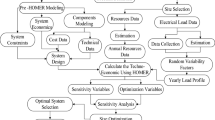Abstract
This paper compares an existing unreliable grid supply with a proposed PV–biodiesel hybrid energy system in order to find the feasibility of the latter for improvement in reliability of power supply, lower pollutant emissions and saving of coal reserves. In the present study, the electrical load of a cement technology institute located in Bhilai, India, has been selected for the purpose of analysis. The results show that hybrid PV–biodiesel system comprising 25 kW PV array, 8 kW biodiesel generator-1, 20 kW biodiesel generator-2, 10 kW inverter and 10 kW rectifier will supply power to the institute avoiding addition of 27.744 tons of CO2 in atmosphere and save 55,080 kg of coal per year with improvement in reliability from 93.15 to 100%.





Similar content being viewed by others
References
Baghdadi, F., Mohammedi, K., Diaf, S., & Behar, O. (2015). Feasibility study and energy conversion analysis of stand-alone hybrid renewable energy system. Energy Conversion and Management, 105, 471–479. doi:10.1016/j.enconman.2015.07.051.
Belmili, H., Haddadi, M., Bacha, S., Almi, M. F., & Bendib, B. (2014). Sizing stand-alone photovoltaic–wind hybrid system: Techno-economic analysis and optimization. Renewable and Sustainable Energy Reviews, 30, 821–832.
Bhattacharjee, S., & Dey, A. (2014). Techno-economic performance evaluation of grid integrated PV–biomass hybrid power generation for rice mill. Sustainable Energy Technologies and Assessments, 7, 6–16.
Chhattisgarh Renewable Energy Development Agency. (2015). Raipur, Chhattisgarh, India. http://www.creda.in/?q=grid-jnnsm. Accessed 12 Oct 2015.
Homer renewable energy software documentation. (2015). http://www.homerenergy.com/documents/MicropowerSystemModelingWithHOMER.pdf. Accessed 07 June 2015.
Kolhe, M. L., Ranaweera, K. I. U., & Gunawardana, A. S. (2015). Techno-economic sizing of off-grid hybrid renewable energy system for rural electrification in Sri Lanka. Sustainable Energy Technologies and Assessments, 11, 53–64.
Liu, G., Rasul, M. G., Amanullah, M. T. O., & Khan, M. M. K. (2012). Techno-economic simulation and optimization of residential grid-connected PV system for the Queensland climate. Renewable Energy, 45, 146–155.
Murphy, P. M., Twaha, S., & Murphy, I. S. (2014). Analysis of the cost of reliable electricity: A new method for analyzing grid connected solar, diesel and hybrid distributed electricity systems considering an unreliable electric grid, with examples in Uganda. Energy, 66, 523–534.
NASA surface meteorology and solar energy, release 6.0. (2015). https://eosweb.larc.nasa.gov/sse/. Accessed 11 May 2015.
Prodromidis, G. N., & Coutelieris, F. A. (2011). A comparative feasibility study of stand-alone and grid connected RES-based systems in several Greek Islands. Renewable Energy, 36, 1957–1963.
Rezzouk, H., & Mellit, A. (2015). Feasibility study and sensitivity analysis of a stand-alone photovoltaic–diesel–battery hybrid energy system in the north of Algeria. Renewable and Sustainable Energy Reviews, 43, 1134–1150.
Sen, R., & Bhattacharyya, S. C. (2014). Off-grid electricity generation with renewable energy technologies in India: An application of HOMER. Renewable Energy, 62, 388–398.
Shezan, S. A., Julai, S., Kibria, M. A., Ullah, K. R., Saidur, R., Chong, W. T., et al. (2016). Performance analysis of an off-grid wind-PV (photovoltaic)–diesel–battery hybrid energy system feasible for remote areas. Journal of Cleaner Production, 125, 121–132.
Sinha, S., & Chandel, S. S. (2014). Review of software tools for hybrid renewable energy systems. Renewable and Sustainable Energy Reviews, 32, 192–205.
Tsuanyo, D., Azoumah, Y., Aussel, D., & Neveu, P. (2015). Modeling and optimization of batteryless hybrid PV (photovoltaic)/diesel systems for off-grid applications. Energy, 86, 152–163.
Author information
Authors and Affiliations
Corresponding author
Rights and permissions
About this article
Cite this article
Makhija, S.P., Dubey, S.P. Feasibility of PV–biodiesel hybrid energy system for a cement technology institute in India. Environ Dev Sustain 20, 377–387 (2018). https://doi.org/10.1007/s10668-016-9886-4
Received:
Accepted:
Published:
Issue Date:
DOI: https://doi.org/10.1007/s10668-016-9886-4




